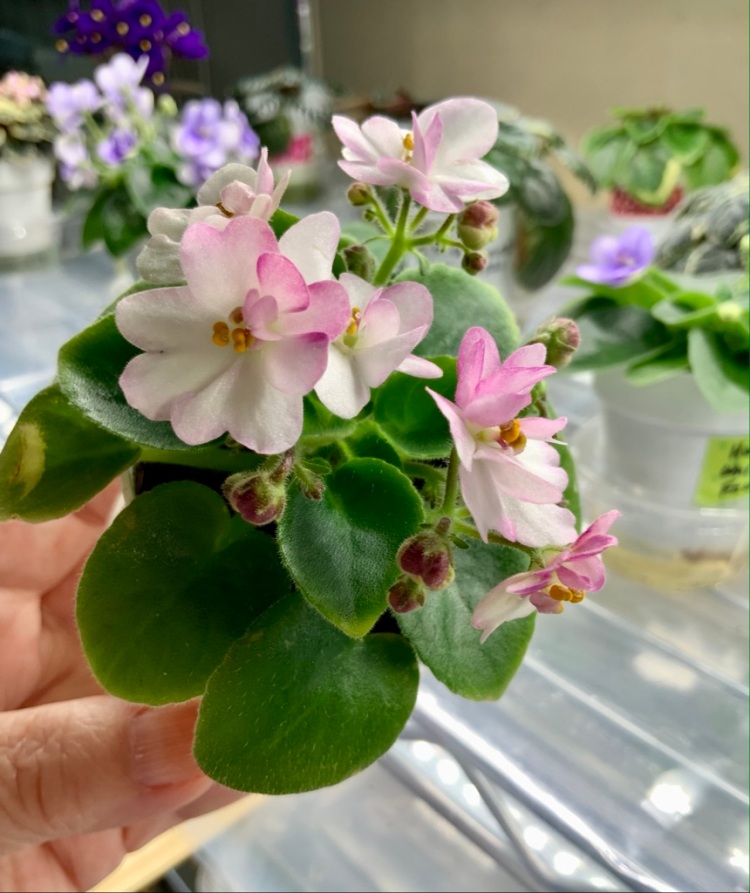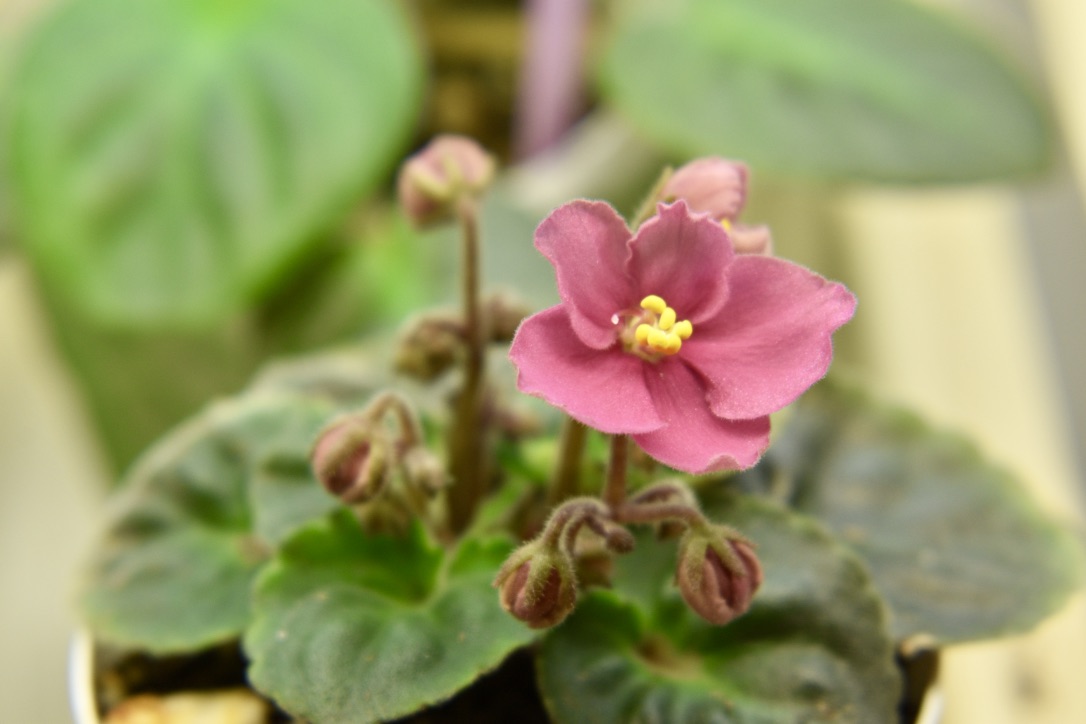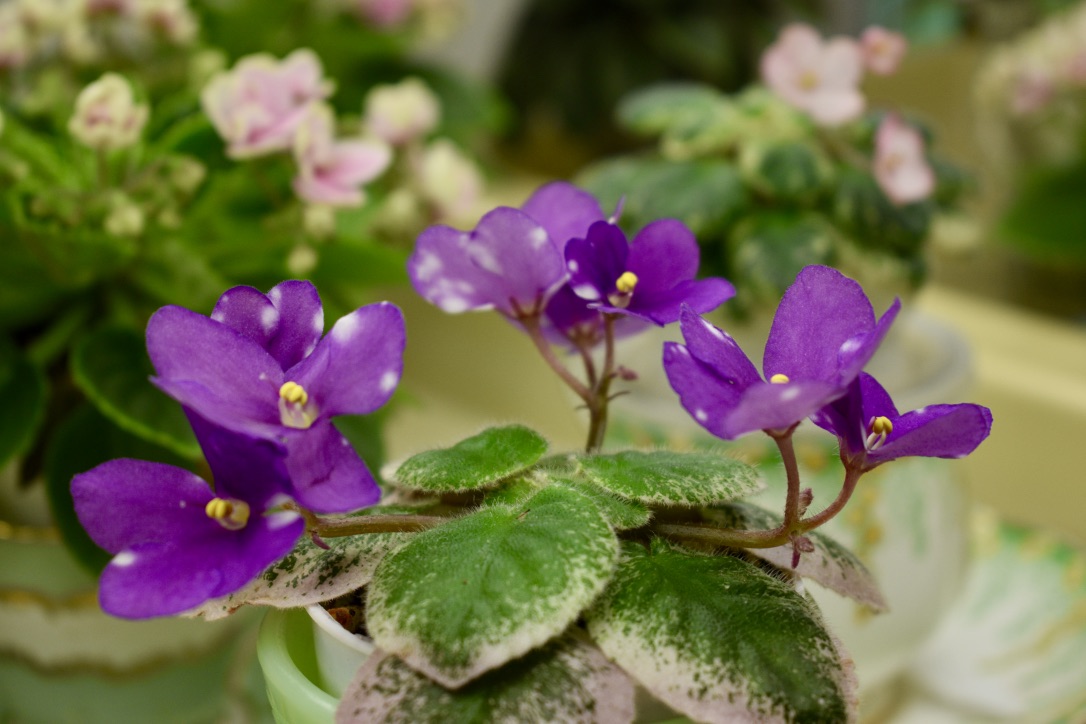


10 Tips for Growing Beautiful African Violets
So, you want to grow African Violets? You can! Provide them with the right conditions, and you will be rewarded with compact clusters of jewel-like flowers on and off throughout the year. Here are tips for growing African Violets in your home or office.
1. LIGHT- African Violets (AVs) need indirect light to allow for photosynthesis. Many growers have success by growing on a windowsill while avoiding direct sunlight, which is too intense. Growers also use artificial light sources. Fluorescent or full spectrum light emitting diodes (LED) are 90% more efficient than standard, incandescent bulbs.
2. TEMPERATURE- African Violets like temperatures between 65-78 degrees Fahrenheit and humidity of 40-60%. If growing these plants on a windowsill, outdoor temperatures may radiate indoors, and you may need to move your plant 1-2 feet away from the window to lessen the cold or heat exposure.
3. WATER- AVs may either be watered from the top or the bottom. If top watering, avoid getting the leaves wet as the light source may burn the moist area of the leaf. Simply dry the leaf off if this occurs. When watering from the bottom, do not leave water sitting in the saucer for longer than 30 minutes so that the roots do not become overly moist. African Violets prefer room temperature water, either rainwater, RO (reverse osmosis) water and tap water all may work. Do not use soft water, as it contains too much sodium. Plants like the pH level to be slightly acidic (6.6 – 6.8), and neutralizers may be needed to obtain the right pH level in the water. If a violet collection becomes larger, many growers use matting or wick watering methods to water many plants at a time.
4. POTTING MIX- African Violets thrive in light, soil-less potting mixes. Commercial AV potting mix combined with perlite at a 60/40 ratio is a good starting place. When potting do not pack the soil too tightly into the pot, as this can damage the delicate roots and reduce water drainage. Repotting is the process of changing to a fresh potting mix. Standard AVs are best repotted about 2 times a year, while minis and semi minis should be repotted every 3-4 months.
5. PROPER POT & SIZE-Plastic, terra cotta, and self-watering pots are all used for AVs. Plastic pots (nonporous) are popular among growers, as they come in many sizes, have bottom holes for drainage, and are inexpensive. Plastic pots can also be easily slipped into a decorative pot. Terra cotta pots are porous and therefore if in a dryer environment, the plant will need more frequent watering. Self-watering pots are effective yet expensive, which may be a consideration if your collection of plants is large. AVs like their roots a bit crowded and will blossom under this condition. Therefore, African Violets should be potted in a container 1/3 the size of the leaf span. For example, a plant with a 12” leaf span will need a 4” pot.
6. GROOMING-Routinely grooming your AVs will keep them looking happy and healthy. Detach all spent (withered) blossoms and damaged, old leaves, and remove dust and dirt from the plant with a soft brush. Remove all baby plants (suckers) with tweezers to avoid growing an additional crown which would result in a misshapen plant. Finally, clean all plants monthly in the sink under a soft spray of lukewarm tap water to remove particles from the plant and excess fertilizer from collecting in the soil. Sanitize your tools between grooming each plant to reduce the risk of spreading disease. Tools can be easily sanitized by household disinfecting wipes.
7. FERTILIZERS-African Violets receive most of their nutrients from photosynthesis but benefit from continuous fertilizing. Each watering should contain a weak amount of fertilizer. The expression to fertilize “weakly, weekly” is a good reminder. There are many popular fertilizers (e.g., Dyna Gro 7-9-5, Optimara 14-12-14, and Peter’s Peat-Lite 15-16-17). Add 1/8 tsp fertilizer to a gallon of water. Avoid stronger mixes, which are not better and can actually harm your plant.
8. PESTS & DISEASES- Inspect your plants routinely for insects and disease. Early detection followed by rapid treatment will help prevent the spread of infestation to your entire collection. Look for wilted leaves, flower blooms not opening (bolted blossoms), spilt pollen, and ridged or tight leaves, which are symptoms of problems. An inexpensive 60x magnifier is a helpful tool for examining soil, leaves, and blossoms. Good air circulation promotes transpiration and helps to prevent fungal growth. If in doubt, toss out diseased plants in a trash receptacle outside of the growing environment due to the possible expense, time, and risk to the other plants.
9. KNOW YOUR PLANT TYPE-Get to know the different types of African Violets: Standard, Miniature, Semi-Miniature which have single crowns; or Trailers, which have multiple crowns. Label your plants and write on the label the date you repotted your plant.
10. BRINGING NEW PLANTS HOME- Before bringing new plants into your home, be sure to remove all buds and flowers and isolate the new plants from the rest of your collection. Microscopic bugs may be present in the soil, but they are difficult to detect until the life cycle progresses, which is 3-6 months.
Remember, what works in one grower’s environment may not work in another. A good idea is to learn from the AV growers in your area. Also, to learn more about growing violets, check out the links provided. Consider joining the African Violet Society of America (www.africanvioletsocietyofamerica.org) or a local affiliate. The national AVSA society website lists violet growing organizations in different parts of the country.
As always you can ask any questions here at the local Denton, TX website. (favsd.org). We look forward to giving any help and getting to know you.